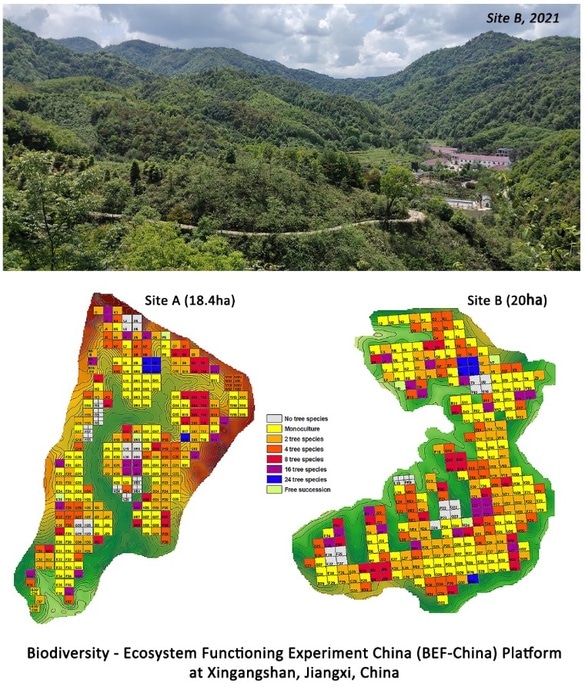According to international research headed by Professor Keping Ma at the Institute of Botany of the Chinese Academy of Sciences (IBCAS), as forests age, differences in species functional traits become more significant and reliable in forecasting forest productivity.

BEF-China experiment sites and the map of the different diversity levels. Image Credit: Xiaojuan Liu.
For the research, Ma and his group analyzed data from a 10-year-old planted mixed forest to identify the influence of functional traits of species in productivity.
The data stems from BEF-China (https://bef-china.com/), the biggest forest biodiversity and ecosystem functioning experiment globally. It comprises over 500 plots covering more than 38 ha of mountainous area.
It is a successful demonstration case from a large biodiversity experiment that shows that functional trait ecology can work if applied in a sound way.”
Keping Ma, Professor, Institute of Botany, Chinese Academy of Sciences
Planting productive mixed forests to recover ecosystem services is a pressing global need. It indicates the kind of trees that needs to be planted to attain high forest productivity with mixed forests, a vital ecosystem service. High productivity indicates high carbon storage and high tree growth, which helps to decrease greenhouse gases and at the same time supply shelter and protect biodiversity.
Earlier research works have revealed that a mix of various species leads to greater productivity compared to single species forests.
This study emphasizes that it is not just the number of species but the specific differences in their functional traits that is important.”
Dr Franca J. Bongers, Study First Author and Postdoc Researcher, Institute of Botany, Chinese Academy of Sciences
Specifically, when planted forests are older than seven years, forests with huge functional diversity achieved increased productivity than forests with low functional diversity or with specifically high average functional traits.
Additionally, achieving the advantage of functional differences between species does not depend on the specific species within the community. This makes it a reliable tool for forest managers to consider.
Reliability in predicting forest functions and services is of utmost importance in connecting restoration actions to goals.”
Dr Xiaojuan Liu, Leader, Management Group for the BEF-China platform
According to Professor Keping Ma, group leader and chair of the BEF-China platform, “restoration projects need reliable tools” to achieve the global goal of mitigating climate change and biodiversity loss.
The international association to record tree growth for a decade of growth is one of its kind. It is also vital to identify yearly specific changes in forest productivity and the impacts of species’ functional traits.
BEF-China was established and is maintained with the help of the collective effort of researchers from China, Germany, and Switzerland.
Source:
Journal reference:
Bongers, F. J., et al. (2021) Functional diversity effects on productivity increase with age in a forest biodiversity experiment. Nature Ecology & Evolution. doi.org/10.1038/s41559-021-01564-3.